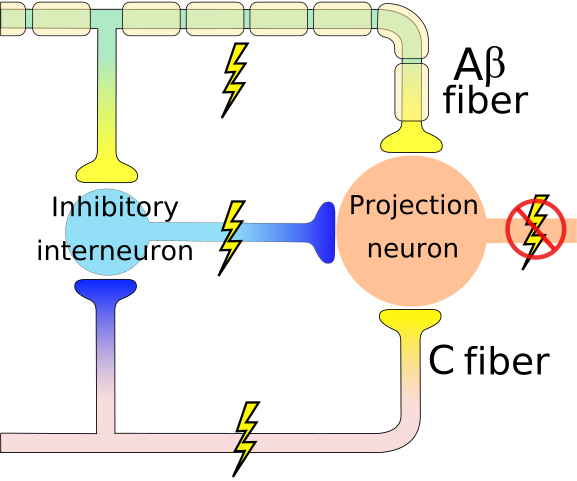本系列文章由 @yhl_leo 出品,转载请注明出处。
文章链接: http://blog.csdn.net/yhl_leo/article/details/51728107
神经网络中常说的闸门机制(Gate Mechanism)或者闸门理论(Gate Theory)源自 Gate Control Theory of Pain,大致原理如下:
Gate Control Theory of Pain (Ronald Melzack and Patrick Wall, 1965):非疼痛的输入可以阻止疼痛的感觉传递到中枢神经系统中。因此,通过无害的刺激输入是可以抑制疼痛的。
non-painful input closes the “gates” to painful input, which prevents pain sensation from traveling to the central nervous system. Therefore, stimulation by non-noxious input is able to suppress pain.

图 1 传入与传出神经
闸门理论,称那些激活但不传递疼痛信号的神经为非感受伤害性纤维(nonnociceptive fibers),它们可以干涉源自疼痛纤维(pain fibers)的信号,从而可以抑制疼痛。传入疼痛感受神经(见图 1,高中生物中有讲述:胞体在脑、脊神经节内,神经末梢在皮肤和肌肉等部位形成感受器)将信号传入中枢神经,包含至少两种神经纤维:
- 快速( speed of travel of a nerve signal (2 to 30 m/s) )、膜较厚(2 to 5 μm in diameter)、有髓鞘的Aδ纤维(A delta fiber),传递剧烈疼痛(intense pain);
- 相对Aδ慢(no more than 2 m/s),膜较薄(0.2-1.5 μm in diameter),无髓鞘的C纤维(C fiber),传递搏动/绞痛、慢性痛(throbbing and chronic pain)。
大直径的Aβ fibers纤维是非感受伤害性纤维,并且能够抑制 Aδ 和 C 纤维 “firing” (很形象的比喻,Aδ, C纤维向投射神经元(projection neuron)投递疼痛信号,好比开火),见图2、3所示的两种状态:
Gate control theory asserts that activation of nerves which do not transmit pain signals, called nonnociceptive fibers, can interfere with signals from pain fibers, thereby inhibiting pain. Afferent pain-receptive nerves, those that bring signals to the brain, comprise at least two kinds of fibers - a fast, relatively thick, myelinated “Aδ” fiber that carries messages quickly with intense pain, and a small, unmyelinated, slow “C” fiber that carries the longer-term throbbing and chronic pain. Large-diameter Aβ fibers are nonnociceptive (do not transmit pain stimuli) and inhibit the effects of firing by Aδ and C fibers.

图 2 Aβ纤维没有激活,C纤维向投射神经元投递疼痛信号,投射神经元将信号传递到中枢神经

图 3 Aβ纤维激活,C纤维向投射神经元投递疼痛信号被抑制性中间神经元抑制,投射神经元不会将疼痛信号传递到中枢神经
周围神经系统(peripheral nervous system, PNS)(相对于中枢神经系统(central nervous system, CNS),见图 4, 是神经系统中的组成部分,分布于大脑和脊髓之外,主要作用是将四肢和器官各处与CNS相连接,本质上就像中介一样建立大脑和脊髓之外的身体部分来回的反馈)具有管理疼痛刺激的中心。灰质后角(见图 5 中灰质2部分)是主要涉及接受源自Aδ 和 C纤维的疼痛刺激、Aβ信号输入的区域。非感受伤害性纤维并不直接抑制疼痛纤维的状态,而是通过图 3所示的中断掉(closing a gate)刺激的传输。在脊髓灰质的其他区域,疼痛纤维也能抑制非感受伤害性纤维,从而(opening the gate)恢复到图 2 所示的状态。

图 4 神经系统简图

图 5 脊髓剖面图蓝色和红色分别表示传入神经元和传出神经元,灰质后角位于2区域
上面的闸门机制是生理学中的简介,而在深度学习中,如何使用该原理,利用各种激活函数,从而实现训练过程收敛的,我还不清楚,等清楚该原理,就会写博客进行讲解。